It is possible to grow edelweiss in your own garden, even if you don't live in the mountains. We explain here what you should pay attention to.
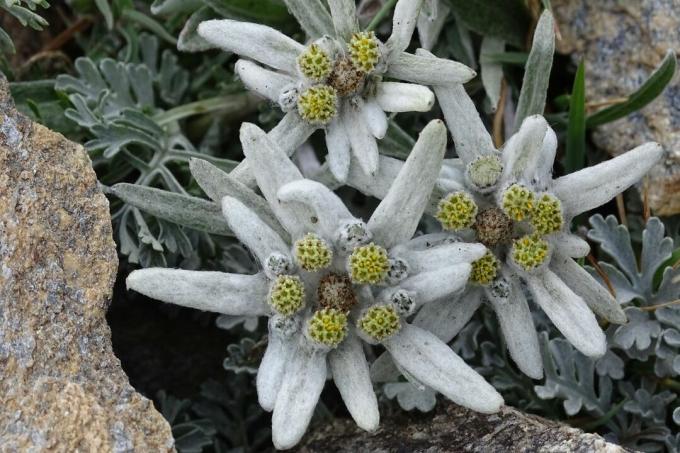
Hardly any other plant is as symbolic as the edelweiss (Leontopodium). It adorns the coat of arms of the German and Austrian Alpine Club, is used by many mountain guards and can be found on various coins. The edelweiss is the official brand of Haflingers and even a beer brand has the edelweiss in its name. The edelweiss is still considered to be a very special and very rare plant. However, breeding made it possible to bring edelweiss into your garden. In this article we explain how edelweiss grows there best and what you need to consider when caring for edelweiss in the garden.
contents
- Edelweiss: origin, flowering time and properties
- The most beautiful species and varieties
-
Plant edelweiss
- Plant edelweiss in the garden
- Edelweiss in a pot
- The most important maintenance measures
- Is edelweiss hardy?
- Multiplication
- Preserve and use edelweiss
Edelweiss: origin, flowering time and properties
The original occurrence of edelweiss is in Asia, Mongolia, Tibet and the Himalayas. The perennial came to Europe around 100,000 years ago, where it can now be found mainly in the mountains at an altitude of between 1,500 and 3,500 meters. In the Alps and Pyrenees, the species Leontopodium alpinum to be found. The plant grows there on barren, stony soils as well as on nutrient-poor blue grass meadows, as it is quite adaptable.

Edelweiss is usually 10 to a maximum of 20 centimeters high, with an unbranched stem on which there are densely hairy leaves. It grows clumpy and forms small, low cushions. The white "blossoms" of edelweiss, so admired by many, are actually not composed of blossoms, but of high-set leaves, so-called bracts. Only on closer inspection do you discover the actual yellow flowers within these bracts. They sit in 2 to 12 flower heads, one of which can contain up to 500 flowers. Edelweiss blooms between June and September.
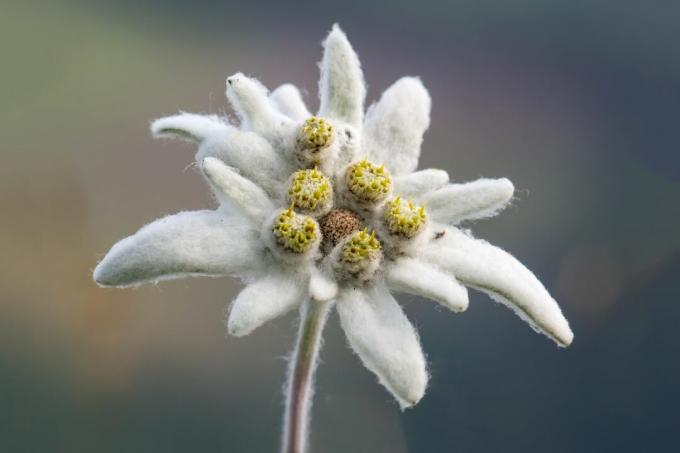
The white, felty hair on the bracts of edelweiss is an adaptation to the great height, because the increased UV radiation not only harms us humans, but also plants. Thanks to the thick hair, edelweiss can render almost all UV radiation harmless. Light with wavelengths that are suitable for photosynthesis, on the other hand, reaches the surface and its energy can be used by the plants. At the same time, the felty hair reflects a lot of light, which attracts the insects required for pollination. Pollinators are also attracted by a sweat-like odor, which is why edelweiss one bee friendly flower is. Not only bees and other insects like the special appearance, but also us humans. The “Edelweiss Tourism” has almost completely eradicated the typical alpine flower. The population is only slowly recovering thanks to various protective measures. For this reason, edelweiss, which can be found in the wild, should not be picked under any circumstances.

Another special feature is the different coloring of the edelweiss depending on the location. The deeper the position in which the edelweiss grows, the larger it becomes, but the less white and hairy the bracts are, so that the whole plant appears more greenish.
The edelweiss is hardy to at least -23 ° C.
The most beautiful species and varieties
Before you can plant edelweiss in the garden, you have to decide on a species and then on a variety. If you want a native plant, you should plant a variety of Alpine edelweiss, but there are also some interesting varieties from the original range in Asia.
Alpine edelweiss (Leontopodium alpinum): This is the species native to our mountains. The alpine edelweiss grows to around 20 cm high and forms small cushions around 20 cm in diameter.
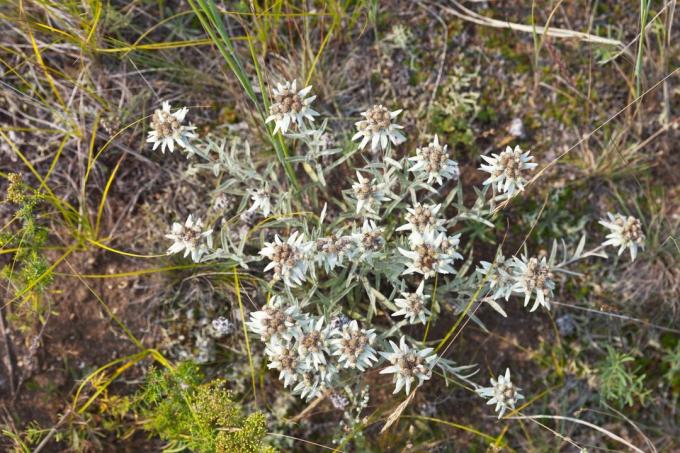
Alpine edelweiss (Leontopodium alpinum ‘Matterhorn’): The ‘Matterhorn’ variety grows very compactly and ramified, but the size and space requirement are roughly the same as for the species.
Alpine edelweiss (Leontopodium alpinum ‘Mont Blanc’): ‘Mont Blanc’ is a particularly early flowering edelweiss variety, which is also characterized by very large flowers. It also becomes about 20 cm high and forms cushion-like clumps of about 20 cm in diameter.
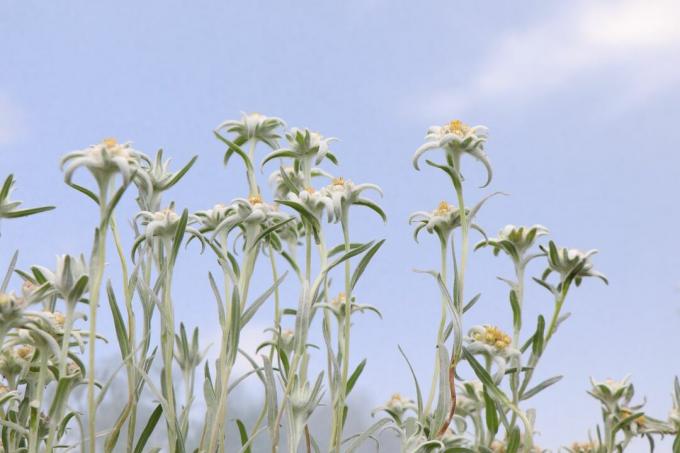
Alpine edelweiss (Leontopodium alpinum ‘Blossom of Snow’): The edelweiss variety ‘Blossom of Snow’ is a new breed. The up to 30 flowers per plant are particularly striking. In addition, ‘Blossom of Snow’ grows up to 40 cm taller and has a clump diameter of around 40 cm more expansively than the other edelweiss species and varieties presented here.
Chinese dwarf edelweiss (Leontopodium souliei): This kind of edelweiss differs from the alpine edelweiss in the sense that it grows lower and forms lawn-like cushions that are densely covered with flowers in summer. You can find the varieties ‘Alpine White’ with a height of 5 to 20 cm or ‘Mignon’, which is a maximum of 10 cm high.
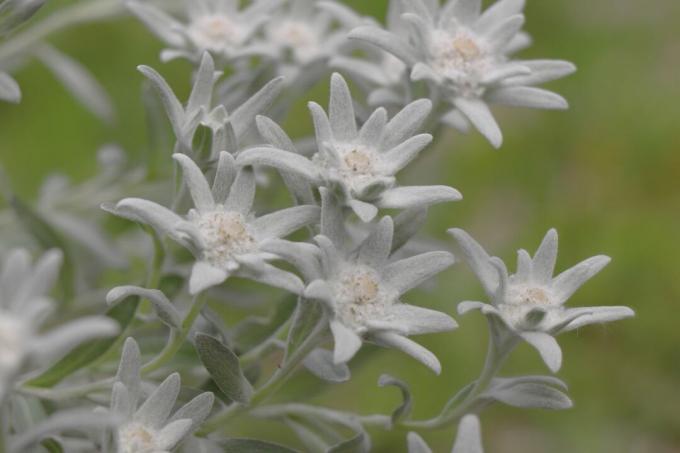
Plant edelweiss
If you want to plant edelweiss in the garden, the right location is essential. It should definitely be sunny and have a calcareous, well-drained, but not too dry, humus and nutrient-poor and stony soil. This is how the edelweiss feels, for example, in Rock gardens very well. Both seeds and young plants are available in stores.
Procedure for sowing edelweiss seeds to give preference to young plants:
- Time: Possible indoors from March in bowls or pots.
- The seeds need a cold stimulus to germinate. Purchased seeds are usually already stratified. However, if you want to be on the safe side, pack the seeds in a bag or jar filled with damp sand and leave them in the refrigerator for about 2 weeks.
- Prepare your growing vessel by covering it with damp, nutrient-poor soil, like ours Plantura organic herbs and potting soil, which should still be made lean with about 20% sand.
- The seeds of the edelweiss are distributed on the earth. However, do not cover them, but only press them lightly: edelweiss is a light germ.
- At 15 to 18 ° C, the germination time is about 15 to 20 days. It is important that the seeds remain moist throughout this time. A mini greenhouse or a foil that is put over the growing container will prevent it from drying out too quickly.
- After 6 to 8 weeks, the young plants can be pricked out into plant beds or individual pots, which should also be filled with a rather nutrient-poor soil. Small edelweiss plants have to be pricked out early, as overgrown young plants often fall victim to fungal diseases.
- Acclimate young edelweiss before planting them out. To do this, put the pricked seedlings outside for only one hour a day for two weeks.

Plant edelweiss in the garden
Regardless of whether you prefer or have bought it, there are a few things to consider when planting in the garden:
time
Purchased edelweiss plants can be planted out in spring or autumn. If you have preferred the plants yourself, they will be ready for planting in the bed in autumn.
The right location for edelweiss plants
Since a naturally suitable location for edelweiss can rarely be found here, a little help is usually required. Those who own a rock garden have a clear advantage as long as they can offer the edelweiss a sunny spot. Planting edelweiss is also possible in normal garden soil. But this should first be done by adding ours, for example Plantura lawn sand can be made more permeable and leaner in a ratio of 1: 1. Good water drainage, combined with constant humidity, are very important for edelweiss to thrive. Therefore, care should be taken to ensure good drainage in the subsurface. In the case of soils that tend to become waterlogged, a layer of gravel or gravel at a depth of 30 cm can help.
Tip: Owners of snail-plagued gardens can also be pleased, because the unloved garden companions do not like edelweiss and only eat it if they cannot find anything else. Therefore, edelweiss can be counted among the snail-resistant plants.
The correct planting distance
For most of the edelweiss species and varieties mentioned in this article, a planting distance of about 20 cm is sufficient, which results in about 25 plants per m². For the Chinese dwarf edelweiss, however, the planting distance should be 25 cm and for the Blossom of Snow variety even 40 cm. Edelweiss should be planted individually or in small groups of 3 to 5 plants in order to come into its own.
What's next
Water the young plants well after you have planted them in the ground. Especially in the first, but also in the following winters, you should protect your edelweiss from frost, for example by covering it with brushwood.
Edelweiss in a pot
Edelweiss can also be planted well in pots. This is usually even more successful than in the garden, as the site conditions can be better controlled here.
- A planter made of a natural material such as clay is best, as it allows water to evaporate more easily. It should also have drainage holes and a diameter of at least 20 cm.
- Fill a drainage layer of gravel, expanded clay or gravel at least 10 cm high into the bottom of the vessel.
- We recommend ours as a substrate, for example Plantura organic universal soil to mix with sand in a ratio of 1: 1. It is also beneficial to have some coarser stones and some lime, for example from ours Organic lawn and garden lime, to add.
- Plant the edelweiss in the soil and water it until the water runs out of the pot.
- The pot should definitely be placed in a sunny place on the balcony, terrace or in the garden. Unfortunately, edelweiss is not suitable as a houseplant.

The most important maintenance measures
In good locations, edelweiss requires almost no maintenance. Even if Leontopodium alpinum appreciates a constant water supply, it tolerates short dry phases better than waterlogging. When watering edelweiss, you should be more restrained, but not completely forget the plant.
Edelweiss grows best in poor soil. Fertilizing edelweiss or even adding compost would be more likely to harm it.
Edelweiss does not have to be cut back either. However, if you want to prevent the self-sowing of edelweiss or keep your garden tidy, you can cut back all withered stems just above the leaf rosette in autumn. For seed production, flower heads can also be left on the plant during the winter and only removed at the end of winter. Basically, when cutting edelweiss, you can always remove everything that has dried up and dead.
Since edelweiss prefers calcareous soils, a little lime can be worked into the soil every 2 to 3 years. But that should only happen if the Soil pH determined became. Because too much lime can also be harmful. In sandy loam soils, for example, around 180 to 240 g of lime per m² should be applied every three years.
Is edelweiss hardy?
Leontopodium alpinum is hardy up to a temperature of -23 to -28 ° C. That means there is usually nothing to worry about in our gardens. The problem of winter for us is more the moisture, because Edelweiss and its not tolerate this Roots can start to rot - it is all the more important to have effective drainage when planting to put on. When edelweiss hibernates in pots, however, the plants should be protected from frost, because here the cold temperatures reach the roots more quickly and can damage them. So pack your edelweiss in the pot with jute sacks or fleece, for example. It can also be placed on an insulating styrofoam or wooden board. The plant should not be placed in the house, as there is too little light here and it is also too warm.
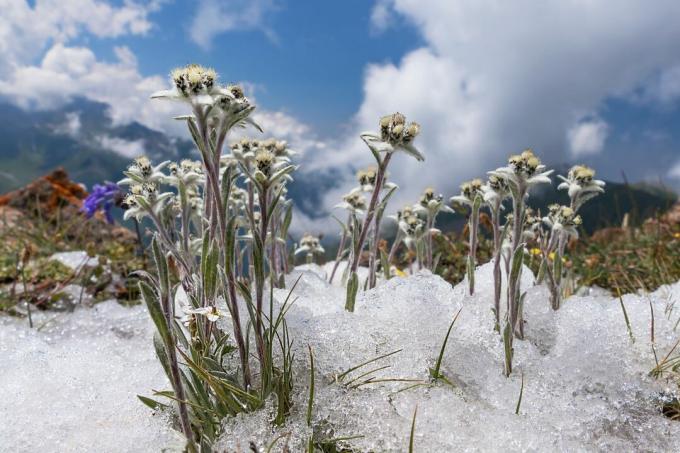
Multiplication
The propagation of edelweiss can be done by seeds or, more easily, by division.
For propagation via seeds, you should not cut the edelweiss in autumn, but leave the flowers on the plant. Around February the seeds that have experienced a natural cold stimulus in this way can then be harvested and sown as described above.
Since edelweiss plants form clumps, they are virtually predestined for reproduction by division. To do this, part of the eyrie, which should have at least two shoots, is cut off and transplanted to a new location in spring or autumn. Sharing has the further advantage that the mother plant is also rejuvenated and stimulated to new growth. However, depending on their growth, edelweiss plants should only be divided every 3 to 4 years when they have developed plenty of shoots and roots again.
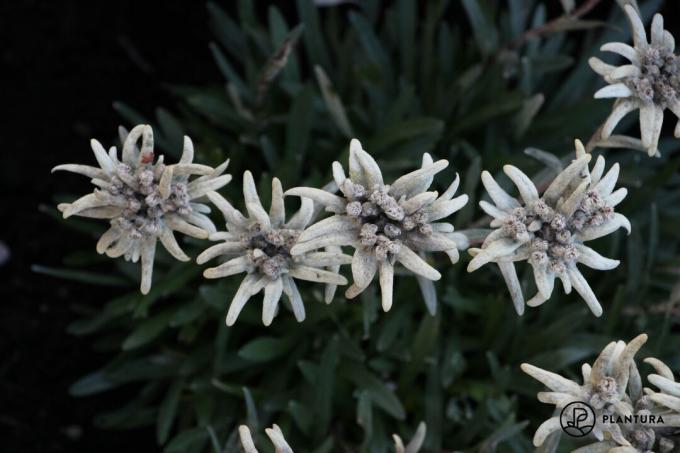
Preserve and use edelweiss
Only flowers from your own garden or garden center should be used for harvesting and preserving edelweiss, because specimens found in nature are protected. In July, the edelweiss flowers are usually fully developed and harvesting can now be carried out until September. Simply cut off the flower stalks just above the leaf rosette. To dry, the edelweiss flowers can be spread out on newspaper, for example, and placed in a warm, but shady and dry place. The flowers should be checked and turned every few days. Alternatively, some flowers can be tied together by the stems and hung up to dry. As soon as the leaves are no longer soft to the touch and rustle dry, they are ready and the dried edelweiss can go to dark storage boxes.
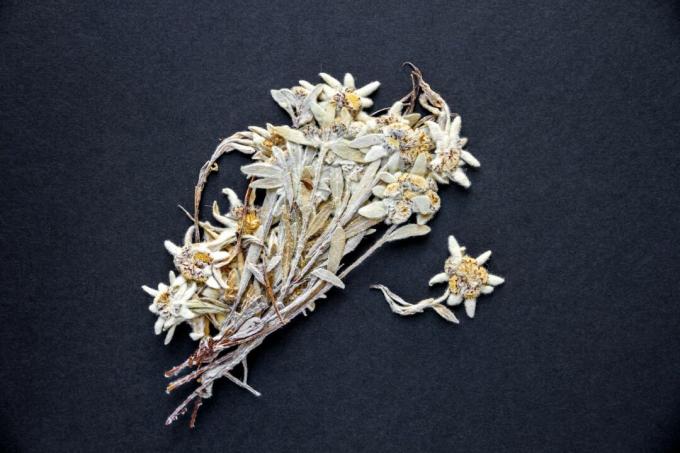
Already in the 16th In the 19th century, edelweiss was used for abdominal pain, diarrhea and other gastrointestinal complaints. The curative effect has meanwhile also been proven by studies on the specific ingredients of the Edelweiss has an antibacterial effect, for example against enterococci, coli bacteria or staphylococci ascribe. In addition, edelweiss extracts are said to have anti-inflammatory and antioxidant effects. In a study, a substance was extracted from edelweiss roots that is effective against vascular wall thickening and can thus be used for the treatment of vascular wall diseases.
A well-suited companion plant for edelweiss is, for example, the mostly blue flowering gentian (Gentiana). You can find more plants that go well with edelweiss in our list of the top 10 Plants for rock gardens.



